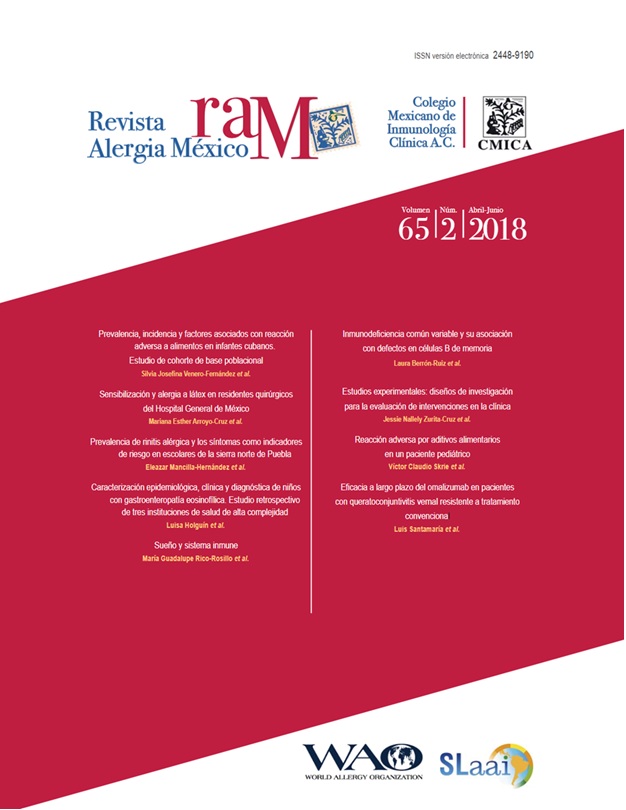Abstract
Common variable immunodeficiency (CVID) is the most common symptomatic immunodeficiency in adulthood. CVID diagnosis is by exclusion and should be considered in patients of any age who have hypogammaglobulinemia of unknown origin. Numerous patients with CVID show alterations in the development of B lymphocytes, both in plasma cells and memory cells. The absence of memory B cells suggests an insufficient germinal reaction, which can be associated with a blockade of the transition of T1 cells into T2 in patients with IDCV, owing to B-cell activating factor (BAFF) receptor deficiency. In patients with IDCV, memory B cell alterations with isotype change favor the development of concomitant comorbidities such as lymphadenopathy, splenomegaly, autoimmunity and granulomatous disease, and multiple classifications that use memory B cells in common have therefore been made trying to generate a classification of patients with IDCV, as well as to establish prognostic factors.
References
Ameratunga R, Woon S, Gillis D, Koopmans W, Steele R. New diagnostic criteria for CVID. Expert Rev Clin Immunol. 2014;10(2):183-186. DOI: 10.1586/1744666X.2014.875274
Abbott JK, Gelfand EW. Common variable immunodeficiency. Diagnosis, management, and treatment. Immuol Allergy Clin North Am. 2015;35(4):637-658. DOI: 10.1016/j.iac.2015.07.009
Resnick ES, Moshier EL, Godbold JH, Cunningham-Rundles C. Morbidity and mortality in common variable immune deficiency over 4 decades. Blood. 2012;119(7):1650-1657. DOI: 10.1182/blood-2011-09-377945
Dong J, Liang H, Wen D, Wang J. Adult common variable immunodeficiency. Am J Med Sci. 2016;351(3):239-243. DOI: 10.1016/j.amjms.2015.12.010
Sánchez LA, Maggadottir SM, Pantell MS, Lugar P, Rundles CC, Sullivan KE, et al. Two sides of the same coin: Pediatric-onset and adult-onset common variable immune deficiency. J Clin Immunol. J Clin Immunol. 2017;37(6):592-602. DOI: 10.1007/s10875-017-0415-5
Bonilla FA, Barlan I, Chapel H, Costa-Carvalho BT, Cunningham-Rundles C, De-La-Morena MT, et al. International Consensus Document (ICON): Common variable immunodeficiency disorders. J Allergy Clin Immunol Pract. 2016;4(1):38-59. DOI: 10.1016/j.jaip.2015.07.025
Warnatz K, Denz A, Dräger R, Braun M, Groth C, et al. Severe deficiency of switched memory B cells (CD27+IgM−IgD−) in subgroups of patients with common variable immunodeficiency: A new approach to classify a heterogeneous disease. Blood 2002 99:1544-1551.
Szczawinska-Poplonyk A, Tapolska-Jozwiak K, Samara H. The B-cell compartment in antibody-deficient infants and young children-developing common variable immunodeficiency or transient immune maturation? Ital J Pediatr. 2016;42(71):1-7. DOI: 10.1186/s13052-016-0279-y
Kurosaki T, Kometani K, Ise W. Memory B cells. Nat Rev Immunol. 2015;15(3):149-159. DOI: 10.1038/nri3802
Seifert M, Küppers R. Human memory B cells. Leukemia. 2016;30(12):2283-2292. DOI: 10.1038/leu.2016.226
Warnatz K, Schlesier M. Flowcytometric phenotyping of common variable immunodeficiency. Cytometry B Clin Cytom. 2008;74(5):261-271. DOI: 10.1002/cyto.b.20432
Poeck H, Wagner M, Battiany J, Rothenfusser S, Wellisch D, Hornung V, et al. Plasmacytoid dendritic cells, antigen, and CpG-C license human B cells for plasma cell differentiation and immunoglobulin production in the absence of T-cell help. Blood. 2004;103(8):3058-3064. DOI: 10.1182/blood-2003-08-2972
Barbosa RR, Silva SL, Silva SP, Melo AC, Pereira-Santos MC, Barata JT, et al. Reduced BAFF-R and increased TACI expression in common variable immunodeficiency. J Clin Immunol. 2014;34(5):573-583. DOI: 10.1007/s10875-014-0047-y
Pott MC, Frede N, Wanders J, Hammarström L, Glocker EO, Glocker C, et al. Autoantibodies against BAFF, APRIL or IL21: An alternative pathogenesis for antibody deficiencies? BMC Immunol. 2017;18:34. DOI: 10.1186/s12865-017-0217-9
Ahn S, Cunningham-Rundles C. Role of B cells in common variable immune deficiency. Expert Rev Clin Immunol. 2009;5(5):557-564. DOI: 10.1586/eci.09.43
Day N, Tangsinmankong N, Ochs H, Rucker R, Picard C, Casanova JL, et al. Interleukin receptor associated kinase (IRAK-4) deficiency associated with bacterial infections and failure to sustain antibody responses. J Pediatr. 2004;144(4):524-526. DOI: 10.1016/j.jpeds.2003.11.025
Azizi G, Abolhassani H, Asgardoon MH, Alinia T, Yazdani R, Mohammadi J, et al. Autoimmunity in common variable immunodeficiency: epidemiology, pathophysiology and management. Expert Rev Clin Immunol. 2016;13(2):101-115. DOI: 10.1080/1744666X.2016.1224664
Rakhmanov M, Keller B, Gutenberger S, Foerster C, Hoenig M, Driessen G, et al. Circulating CD21low B cells in common variable immunodeficiency resemble tissue homing, innate-like B cells. Proc Natl Acad Sci U S A. 2009;106(32):13451-13456. DOI: 10.1073/pnas.0901984106
Berrón-Ruiz L, López-Herrera G, Vargas-Hernández A. Lymphocytes and B-cell abnormalities in patients with common variable immunodeficiency (CVID). Allergol Immunopathol (Madr). 2014;42(1):35-43. DOI: 10.1016/j.aller.2012.07.016
Piqueras B, Lavenu-Bombled C, Galicier L, Bergeron-Van-Der-Cruyssen F, Mouthon L, Chevret S, et al. Common variable immunodeficiency patient classification based on impaired B cell memory differentiation correlates with clinical aspects. J Clin Immunol. 2003;23(5):385-400.
Wehr C, Kivioja T, Schmitt C, Ferry B, Witte T, Eren E, et al . The EUROclass trial: Defining subgroups in common variable immunodeficiency. Blood. 2008;111(1):77-85. DOI: 10.1182/blood-2007-06-091744
Yazdani R, Seify R, Ganjalikhani-Hakemi M, Abolhassani H, Eskandari N, Golsaz-Shirazi F, et al. Comparison of various classifications for patients with common variable immunodeficiency (CVID) using measurement of B-cell subsets. Allergol Immunopathol (Madr). 2017;45(2):183-192. DOI: 10.1016/j.aller.2016.07.001
Rösel AL, Scheibenbogen C, Schliesser U, Sollwedel A, Hoffmeister B, Hanitsch L, et al. Classification of common variable immunodeficiencies using flow cytometry and a memory B-cell functionality assay. J Allergy Clin Immunol. 2015;135(1):198-208. DOI: 10.1016/j.jaci.2014.06.022

This work is licensed under a Creative Commons Attribution-NonCommercial 4.0 International License.
Copyright (c) 2018 Revista Alergia México

